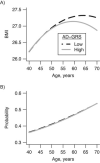Extension of Mendelian Randomization to Identify Earliest Manifestations of Alzheimer Disease: Association of Genetic Risk Score for Alzheimer Disease With Lower Body Mass Index by Age 50 Years
- PMID: 33843952
- PMCID: PMC8576370
- DOI: 10.1093/aje/kwab103
Extension of Mendelian Randomization to Identify Earliest Manifestations of Alzheimer Disease: Association of Genetic Risk Score for Alzheimer Disease With Lower Body Mass Index by Age 50 Years
Abstract
Weight loss or lower body mass index (BMI) could be an early symptom of Alzheimer disease (AD), but when this begins to emerge is difficult to estimate with traditional observational data. In an extension of Mendelian randomization, we leveraged variation in genetic risk for late-onset AD risk to estimate the causal effect of AD on BMI and the earliest ages at which AD-related weight loss (or lower BMI as a proxy) occurs. We studied UK Biobank participants enrolled in 2006-2010, who were without dementia, aged 39-73, with European genetic ancestry. BMI was calculated with measured height/weight (weight (kg)/height (m)2). An AD genetic risk score (AD-GRS) was calculated based on 23 genetic variants. Using linear regressions, we tested the association of AD-GRS with BMI, stratified by decade, and calculated the age of divergence in BMI trends between low and high AD-GRS. AD-GRS was not associated with BMI in 39- to 49-year-olds (β = 0.00, 95% confidence interval (CI): -0.03, 0.03). AD-GRS was associated with lower BMI in 50- to 59-year-olds (β = -0.03, 95% CI: -0.06, -0.01) and 60- to 73-year-olds (β = -0.09, 95% CI:-0.12, -0.07). Model-based BMI age curves for high versus low AD-GRS began to diverge after age 47 years. Sensitivity analyses found no evidence for pleiotropy or survival bias. Longitudinal replication is needed; however, our findings suggest that AD genes might begin to reduce BMI decades prior to dementia diagnosis.
Keywords: Alzheimer disease; Mendelian randomization; body mass index; disease natural history.
© The Author(s) 2021. Published by Oxford University Press on behalf of the Johns Hopkins Bloomberg School of Public Health. All rights reserved. For permissions, please e-mail: journals.permissions@oup.com.
Figures


Similar articles
-
Association of genetic risk score for Alzheimer's disease with late-life body mass index in all of us: Evaluating reverse causation.Alzheimers Dement. 2025 Apr;21(4):e14598. doi: 10.1002/alz.14598. Alzheimers Dement. 2025. PMID: 40189781 Free PMC article.
-
Body mass index, genetic susceptibility, and Alzheimer's disease: a longitudinal study based on 475,813 participants from the UK Biobank.J Transl Med. 2022 Sep 9;20(1):417. doi: 10.1186/s12967-022-03621-2. J Transl Med. 2022. PMID: 36085169 Free PMC article.
-
Sleep duration, genetic susceptibility, and Alzheimer's disease: a longitudinal UK Biobank-based study.BMC Geriatr. 2022 Aug 2;22(1):638. doi: 10.1186/s12877-022-03298-8. BMC Geriatr. 2022. PMID: 35918656 Free PMC article.
-
Body mass index: Has epidemiology started to break down causal contributions to health and disease?Obesity (Silver Spring). 2016 Aug;24(8):1630-8. doi: 10.1002/oby.21554. Obesity (Silver Spring). 2016. PMID: 27460712 Free PMC article. Review.
-
A global view of the genetic basis of Alzheimer disease.Nat Rev Neurol. 2023 May;19(5):261-277. doi: 10.1038/s41582-023-00789-z. Epub 2023 Apr 6. Nat Rev Neurol. 2023. PMID: 37024647 Free PMC article. Review.
Cited by
-
Advances in Genetic Risk Scores for Alzheimer's Disease and Dementia: A Systematic Review.Neurol Int. 2025 Jun 26;17(7):99. doi: 10.3390/neurolint17070099. Neurol Int. 2025. PMID: 40710902 Free PMC article. Review.
-
Adiponectin Gene Polymorphisms: A Case-Control Study on Their Role in Late-Onset Alzheimer's Disease Risk.Life (Basel). 2024 Mar 7;14(3):346. doi: 10.3390/life14030346. Life (Basel). 2024. PMID: 38541671 Free PMC article.
-
Snoring and risk of dementia: a prospective cohort and Mendelian randomization study.Sleep. 2025 Jan 13;48(1):zsae149. doi: 10.1093/sleep/zsae149. Sleep. 2025. PMID: 38943476 Free PMC article.
-
Weight loss in a cardiovascular trial population identifies people at future risk of dementia.Alzheimers Dement (Amst). 2022 Aug 30;14(1):e12352. doi: 10.1002/dad2.12352. eCollection 2022. Alzheimers Dement (Amst). 2022. PMID: 36092692 Free PMC article.
-
A bidirectional Mendelian randomisation study to evaluate the relationship between body constitution and hearing loss.Sci Rep. 2023 Oct 27;13(1):18434. doi: 10.1038/s41598-023-44735-x. Sci Rep. 2023. PMID: 37891192 Free PMC article.

